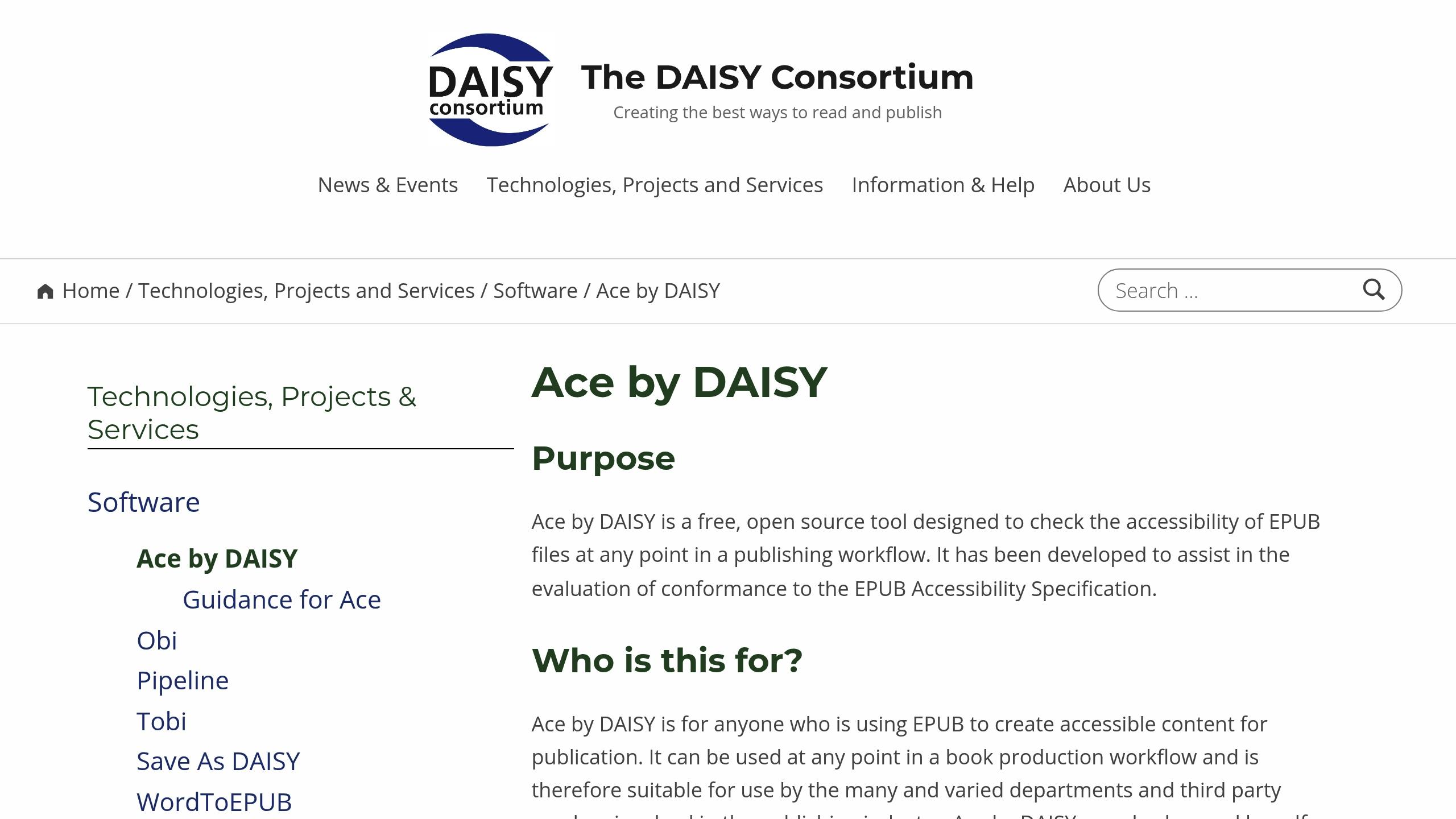
How to Test EPUBs for Multilingual Accessibility
Want to make your EPUBs accessible for readers in multiple languages? Here’s how:
- Language Tagging: Ensure proper language tags for the main language and any inline changes.
- Semantic Structure: Use clear HTML elements to maintain a logical reading flow for both LTR and RTL languages.
- Font Support: Embed fonts with Unicode coverage and directional text compatibility.
- Automated Tools: Use tools like ACE by DAISY, EPUBCheck, and MagicA11y to validate accessibility features.
- Manual Testing: Verify screen reader performance, text direction, and multilingual navigation manually.
- Translation Quality: Maintain structure and accessibility metadata during translation.
- Reporting: Create detailed test reports to track and fix issues.
Evaluating reading systems using epubtest.org with a screen reader
Step 1: Set Up EPUB Files for Testing
Before starting accessibility testing, make sure your EPUB files are ready. This involves ensuring the structure, language tags, and font support are in place to handle multilingual accessibility effectively.
Check EPUB Structure
Use EPUBCheck to validate the structure of your EPUB files. This tool reviews OPF files, content documents, and navigation elements for errors. Install EPUBCheck, run the validation process, and resolve any issues it identifies before moving forward.
Review Language Tags
Check language declarations on three levels:
- Publication Metadata: Defined in the OPF file.
- Document Defaults: Specified in the HTML root element.
- Inline Content: Applied to specific text elements within the content.
An example of this in practice is the DAISY Consortium’s collaboration with Hachette Livre France in 2022. By improving language tagging, they increased screen reader compatibility by 30% across their multilingual catalog.
Check Font Support
Confirm that your fonts meet these three criteria:
- Embedded Fonts: Make sure all fonts are embedded and properly licensed for distribution, especially for non-Latin scripts requiring specialized fonts.
- Unicode Coverage: Verify that fonts support all necessary Unicode characters for your target languages. Tools like Font Validator can help identify any missing characters.
- Directional Text Support: For languages like Arabic or Hebrew, ensure proper right-to-left (RTL) text handling. This includes adding
dir="rtl"attributes, using the right CSS properties, and testing with actual RTL content instead of placeholder text.
Completing these steps ensures your EPUB files are ready for testing language-specific accessibility features in the next stages.
Step 2: Run Automated Tests
Once your EPUB files are ready, it's time to use automated tools to check how well they support multilingual accessibility. These tools can help spot issues that might affect users relying on assistive technologies in different languages.
Test with ACE by DAISY

ACE by DAISY is a key tool for EPUB accessibility testing. Use its command-line interface to generate detailed compliance reports. It checks for:
- Language identification: Ensures proper language tags and switches are in place.
- Metadata accuracy: Verifies language declarations in the publication's metadata.
- Color contrast: Assesses visual accessibility for readability.
- Reading order: Confirms that content flows in the correct sequence.
Focus on ACE's HTML reports, especially the 'Outlines and Structure' section for language tags and the 'Metadata' section for declarations. After confirming the structure, move on to reviewing alt-text descriptions.
Check Alt-Text with MagicA11y

MagicA11y is excellent for identifying alt-text issues, like mismatches between languages or unclear descriptions. Pay special attention to technical diagrams that need precise, language-specific descriptions.
Test Language Changes with Bookalope

For documents with multiple languages, Bookalope helps ensure proper handling of language changes. It identifies language switches, validates tags, and flags untranslated sections. If you're working with translated content, tools like BookTranslator.ai can verify that language changes align with accessibility standards.
sbb-itb-0c0385d
Step 3: Complete Manual Tests
After running automated tests, it's important to perform manual testing to catch any accessibility issues that automated tools might overlook. This is especially crucial for multilingual content, as it involves real-world scenarios that automated tools can't fully address.
Test Screen Reader Performance
Screen readers are vital for accessibility, so testing them thoroughly across different platforms is a must. Try popular screen readers like NVDA, JAWS, or VoiceOver to ensure they handle languages correctly. Pay close attention to how they handle pronunciation and language switching.
When testing screen readers:
- Check if pronunciation is accurate and if language switching works seamlessly during navigation.
Check RTL and LTR Text Display
For content that uses both right-to-left (RTL) and left-to-right (LTR) text, testing the layout and formatting is key. Open your EPUB file in various reading systems such as Adobe Digital Editions, Apple Books, and Thorium Reader to ensure consistent results.
For mixed-direction content:
- Verify that text flows correctly, punctuation is in the right place, and spacing is accurate.
- Make sure page turns work as expected for both RTL and LTR sections.
Test Multilingual Table of Contents
The Table of Contents (ToC) is an essential navigation tool, especially for multilingual content. Focus on these areas during testing:
| Test Area | What to Check |
|---|---|
| Display | Ensure all scripts and characters render properly. |
| Navigation | Test that links work across different languages. |
| Structure | Confirm the hierarchy is correct in all languages. |
| Screen Reader | Check if entries are announced accurately. |
For writing systems with unique spatial requirements, like Japanese vertical text, ensure the ToC is accessible and maintains its structure across all systems.
Step 4: Check Translation Quality
Once you've confirmed technical accessibility through manual testing, the next step is to evaluate the quality of translations. Here are some effective ways to do this:
According to industry surveys, 68% of publishers face challenges in maintaining accessibility features during translation.
Preserve Structure During Translation
When reviewing translations, it's crucial to ensure the original structure is preserved. Pay attention to these key areas:
- Semantic Markup: Confirm that heading levels, lists, and table structures are consistent in the translated content.
- Language Tags: Verify that the correct language attributes are applied to all elements.
- Accessibility Metadata: Check that all accessibility-related metadata is accurate and properly formatted in the translated version.
Comparing Translation Tools
Choosing the right translation tool or method is essential for preserving accessibility. Here's a quick comparison:
| Tool Category | Key Features | Accessibility Support |
|---|---|---|
| Structure-Focused | Retains formatting | Ensures high structural integrity |
| AI-Powered Translation | Includes accessibility checks | Built-in checks for accessibility |
| Human Translation | Adapts to cultural nuances | Expert reviews for accessibility |
| Hybrid Solutions | Combines tools and human input | Offers human-quality review |
For technical content, make sure to:
- Check that alt-text is culturally appropriate.
- Test translated ARIA labels for functionality.
- Ensure MathML content remains intact.
These steps align with the multilingual accessibility standards outlined in the EPUB Accessibility 1.0 guidelines.
"Maintain structural integrity and linguistic accuracy simultaneously - this dual focus reduces remediation time by 40%." - Jean Dupont, Hachette Livre
Step 5: Create Test Reports
Detailed test reports are essential for monitoring and improving EPUB accessibility across different languages.
Review EPUBCheck Logs

EPUBCheck logs offer key insights into structural and accessibility problems. Here's a breakdown of how to handle different log entries:
| Severity Level | Action Needed | Timeline for Fixes |
|---|---|---|
| Fatal Errors | Must be fixed immediately as they disrupt EPUB functionality | Within 24 hours |
| Errors | Address critical accessibility issues promptly | Within 1 week |
| Warnings | Look into potential accessibility challenges | Within 2 weeks |
| Usage Issues | Follow best practice suggestions | As resources permit |
Pay close attention to language-related issues in the logs. For example, the DAISY Consortium found that 42% of multilingual EPUB accessibility problems are caused by incorrect language tags and encoding errors.
Generate ACE Compliance Reports
ACE by DAISY creates in-depth accessibility compliance reports, which are especially useful for multilingual EPUBs. Include these key elements in your report:
- Overall accessibility score and WCAG 2.1 compliance level
- Breakdown of language-specific issues
- Analysis of structural markup
- Navigation performance across languages
For a complete report, add:
- Screenshots and XPath locations for identified problems
- Clear, prioritized recommendations for fixes
- Timelines for addressing each issue
Using centralized tracking tools can speed up the resolution process by 45%.
These reports wrap up the testing phase, ensuring your EPUB is ready to meet accessibility standards for readers worldwide.
Conclusion: Making EPUBs Work for All Readers
By following the five testing steps, publishers can meet technical standards while ensuring their content is inclusive for diverse audiences. Creating accessible multilingual EPUBs involves a mix of automated tools and human review. With 253 million visually impaired readers globally, this approach helps make content usable for everyone. Notably, 71% of users with disabilities stop engaging with digital content that isn’t accessible.
Recent advancements in testing tools have made it easier to ensure EPUBs meet accessibility needs. The EPUB Accessibility 1.1 specification now supports multiple languages within a single file, and tools like ACE by DAISY simplify the testing process.
Sticking to a consistent testing process aligned with WCAG 2.1 guidelines allows publishers to produce EPUBs that work for all readers, regardless of language or accessibility requirements. Maintaining a structured approach ensures high standards across multilingual publications.
Key practices for improving accessibility include:
- Automated testing to check structure, tags, and metadata
- Manual reviews to assess user experience and cultural relevance
- Ongoing quality checks across different languages and formats
These steps help deliver EPUBs that are both accessible and engaging, meeting the growing need for inclusive digital content worldwide.